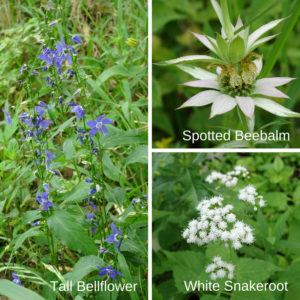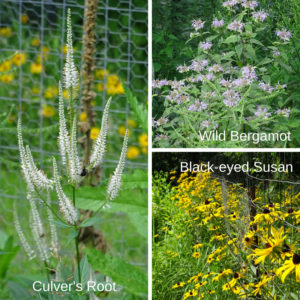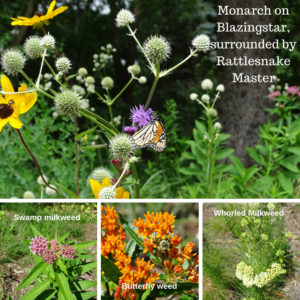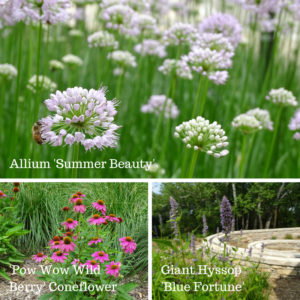What’s blooming at Discovery Point?
The restoration area and grounds are abuzz with color and pollinators right now. Stop over and enjoy the beauty of summer! Below are some of the more common flowers you will see if you visit in the next few weeks.
Restoration area and general grounds
Tall Bellflower: This purple flower is favored by long tongued bees.Though its name is bell flower, the flowers are usually more flat than bell-like. You can find it near the parking lot in the restored area.
Spotted beebalm or spotted horsemint: Those long white bits look like flowers, but they’re actually modified leaves, called bracts. Look closer to find the small, yellow, spotted flowers underneath the showier bracts. A member of the mint family, Spotted Beebalm leaves give off a minty smell when crushed. You can find it near the Deer Exclusion fence in the restoration area close to the driveway.
White Snakeroot: This is one of the last woodland plants to flower, with the little white flowers lasting into September. It was historically the cause of “milk sickness” when the toxin in the leaves tainted milk of grazing cows, sickening people who drank the milk. Due to modern agricultural practices, this disease is no longer a concern. This flower is very common in the non-restored, wooded areas around Discovery Point, but especially on the southwest side of the building.
Seating Area behind building

Culver’s Root: The upright spikes of this plant provide needed resources for the Rusty-patched bumblebee, an endangered bee, as well as sweat bees, leaf cutter bees and butterflies.
Wild Bergamot: Also called bee balm, this flower is a favorite of bees, moths, hummingbirds and butterflies. Some bees and wasps even cheat by chewing a hole near the base of flower to get at the nectar, thereby getting around the long tube of the flower. Its leaves are also very aromatic, and can be used to make tea.
Black-eyed Susans: This plant has tiny hairs all over the stems and leaves–an adaptation to help the plant conserve water on the prairie, where it is windy and sunny. The biggest group we have on Discovery Point grounds right now can be found in the back by the seating area, but you can also see them in the restoration area east of the driveway, as well as in the prairie strip on the north side of the parking lot.
Prairie Strip by the parking lot
Blazingstar: This is the purple button-like flower in the middle of the top photo. Blazingstars are butterfly magnets, and you will often see more than one monarch on the plant at a time. Many of the Blazingstars planted at Discovery Point were eaten by deer and rabbits; this is the first year we have seen them blooming.
Rattlesnake Master: The spiky head of the Rattlesnake Master isn’t what some would think of as a typical flower, but many bees and butterflies rely on it. The leaves of the plant look like yucca, with small spikes on the edges.
Milkweeds: We have three milkweed species (Swamp, Butterfly weed and Whorled) blooming all around Discovery Point, but you can see them all together in the Prairie to the north of the parking lot. Whorled milkweed is not as showy as the others, with smaller white flowers and thin leaves. Monarch caterpillars use all of these milkweeds, and the adults visit all of them as well.
Near the building
Many of the plants in the landscaped beds around our building were chosen for their drought tolerance. They demonstrate a more manicured look that requires less watering and maintenance than traditional landscape designs. Many were also chosen because they do not create viable seeds, and so do not spread, maintaining the geometric patterns in which they were planted.
 Allium ‘Summer Beauty’: The flowers of the Allium plants on our front walkway nod and bob like pom-poms in the breeze. However, they are related to onions and chives, and the leaves have a distinct onion odor when broken.
Allium ‘Summer Beauty’: The flowers of the Allium plants on our front walkway nod and bob like pom-poms in the breeze. However, they are related to onions and chives, and the leaves have a distinct onion odor when broken.
‘PowWow Wild Berry’ Coneflower: A variety of the native Purple Coneflower, these dark magenta flowers are very drought tolerant. It also has a very long blooming season.
Giant Hyssop ‘Blue Fortune’: This is a cultivar (short for cultivated variety) of the native Anise Hyssop. When crushed, the leaves give off a licorice smell. Bees and butterflies love these tall purple flowers. You can see the Blue Fortune variety outside our back door, and the smaller, native Hyssop in the prairie strip north of the parking lot.
